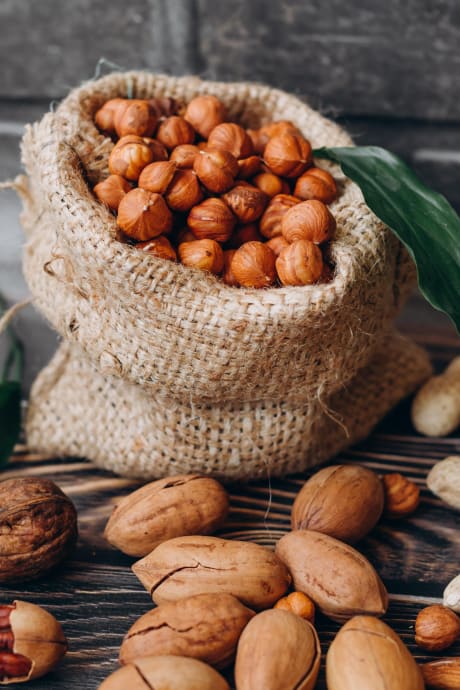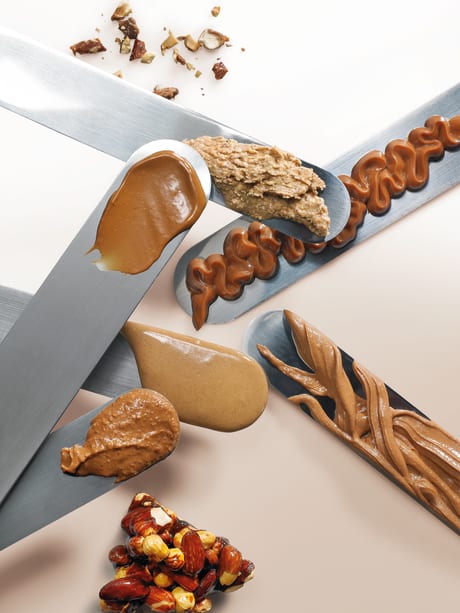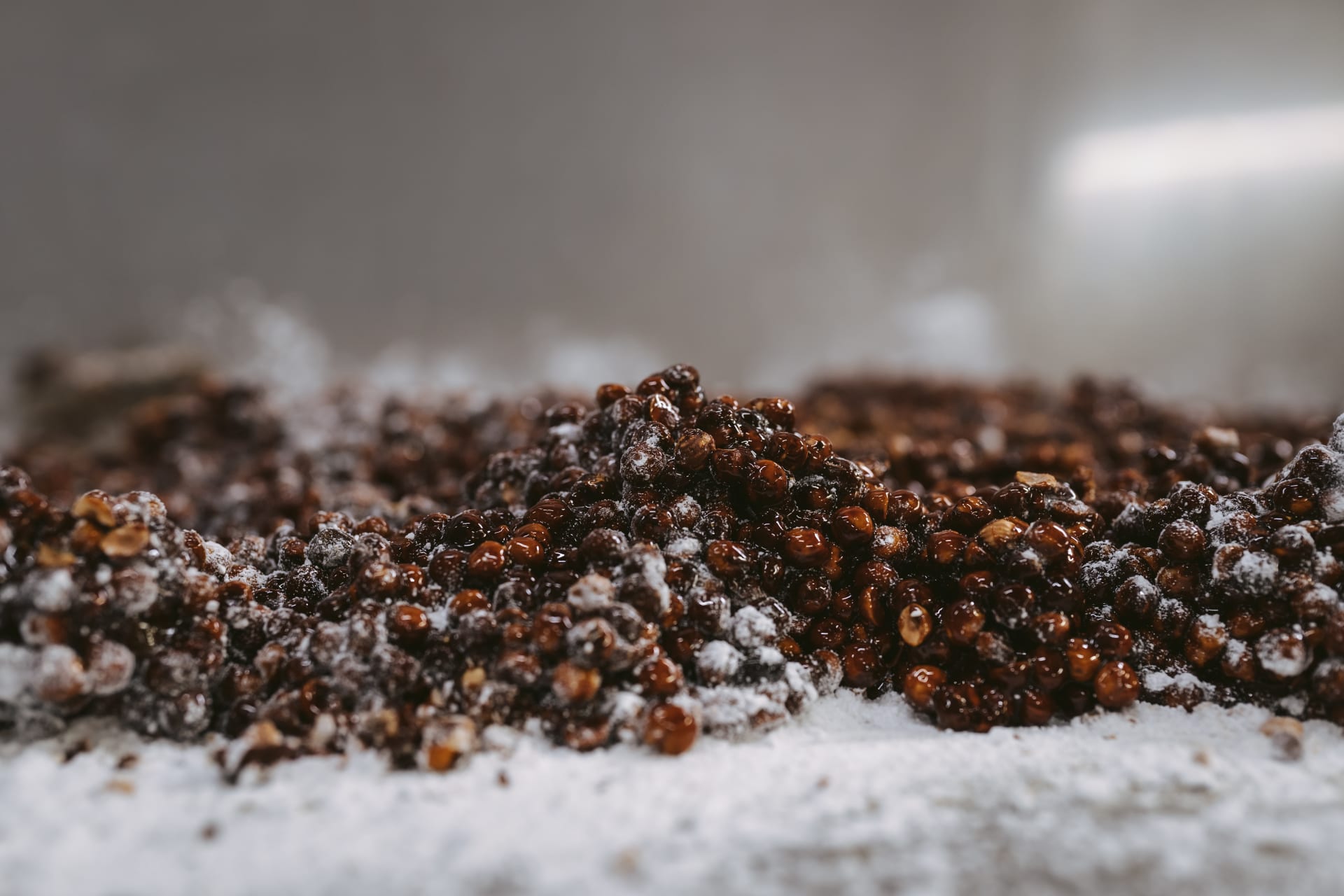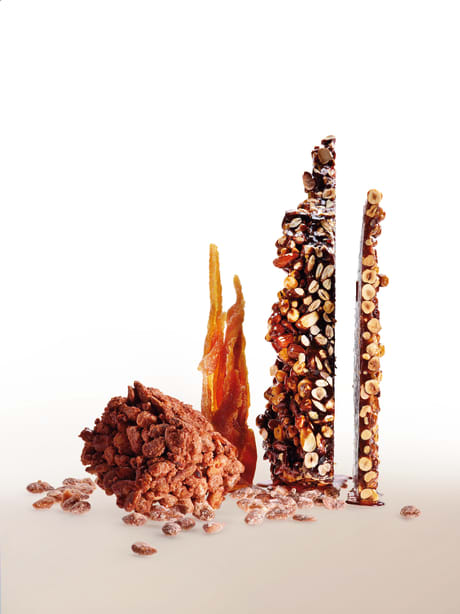You are using an outdated browser. Please upgrade your browser to improve your experience and security.
Praliné
Contents :
- What is praliné made of?
- How is praliné made?
- Valrhona pralinés’ two manufacturing processes
- Praliné recipe
- Preserving pralinés
Praliné is a nut-based paste used widely in pastry-making. It’s not to be confused with praline, which is a candy coated with caramelized sugar. It can be found in many classic dessert recipes such as Paris-Brest pastries, but also in couverture chocolate-coated praliné bonbons - and not forgetting creations by Valrhona chefs such as praliné crémeux and custard-based praliné mousse. But how do we make praliné?
What is praliné made of?
Praliné is mainly made of two ingredients: at least 50% nuts and sugar. You can add vanilla (as a bean or natural extract) or lecithin.
The nuts most frequently used are hazelnuts and almonds. Depending on the recipe, we might prefer one over the other, bearing in mind that hazelnut contains about 60% fat and almond about 50%. Almond praliné is used to make, for example, pink almond tarts.
The Valrhona pralinés range most often uses an equal blend of almonds and hazelnuts. There are also pralinés that combine almond with other nuts, such as pecans, cashews, macadamias and pistachios.
For example, Valrhona’s one-of-a-kind range offers a mix of original flavors - coconut and almond, pecan and pistachio - for indulgent, surprising creations.
How is praliné made?
Praliné production involves several stages: weighing, cooking, cooling, pre-grinding, grinding, homogenization and packaging. These are the same steps used to make gianduja, where grinding is the first step. In both cases, people’s expertise is an essential ingredient in a quality praliné.
Pralinés first appeared in Valrhona’s workshops 100 years ago. Expertise perfected over years is used at every stage of the process to ensure each praliné has a consistent taste and texture.
Weighing and cooking
First, the ingredients are carefully weighed. Depending on the manufacturing process (as we will see below), they may or may not be mixed, in which case the cooking is not quite the same. While cooking times are standardized, operators mainly manage this part of the process depending on what they can see and smell. They have real expertise in checking how well cooked the nuts and sugar are.
Cooling
The operator then empties the pot and places the mixture on a cooling table. This is a table whose underside is kept at low temperature by a channel of cold water. This makes it possible to cool the nuts and harden the caramel formed during cooking, which will aid the next step: grinding.
Pre-grinding and grinding
The nuts then go in a pre-grinder, which crushes them, before they go in a grinder, which turns them into a very fine powder. The fat starts to come out of the nuts during this very fine grinding process.
Homogenization
This powder is then placed in a homogenizer, a machine that closely resembles the conche used to make chocolate. Its temperature increases to liquefy the fat and bring out all the praliné’s aromas.
Mixing helps to homogenize the mixture - in other words, to distribute the nuts’ and sugar’s dry matter in the fat effectively - and this will affect the praliné’s viscosity.
Valrhona pralinés’ two manufacturing processes
Valrhona has used two praliné manufacturing processes since it was first created: Caramelized cooking for its Caramelized Power range and chouchou cooking (sometimes also described as “sugar-coating”) for its Nut Revelation range. Depending on the process chosen, there are differences in weighing, cooking and cooling. Each one gives a different taste, accentuating or downplaying the caramel or nut notes.
Caramelized cooking: bringing out the caramel
The first process involves the following steps:
- Roast the nuts (expose them to a heat source to give them a toasted fragrance). At Valrhona, the nuts we buy are already roasted.
- Cook the sugar alone in a large pot to make a caramel. An authentic caramel is made in a large copper pot.
- When the caramel takes on the desired color, add the roasted nuts for a few moments, then stop cooking.
The mixture is cooled on a table. The result is a kind of nougatine that will be crushed and refined to create intensely caramelized pralinés. This process is the hallmark of Valrhona’s pralinés.
Chouchou cooking: bringing out the nuts
The second process emphasizes the raw taste of green almonds and fresh hazelnuts:
- Cook the nuts and sugar together in a large pot.
- When the mixture starts to caramelize around the edges - this is the sugar “coating” the nuts - stop cooking.
These caramelized nuts resemble the “chouchous” sold on French beaches, which is why Valrhona’s teams describe them as having a “chouchou texture”. This technique is known as sablage in French (which roughly translates as “crumbling”), and it is what gives the warm, full-bodied nutty notes in Valrhona’s Nutty Praliné range all their intensity and elegance.
Praliné recipe:
You are now familiar with how Valrhona makes its pralinés in its chocolate factory. But maybe you need to make praliné in your kitchen? Here is a simple recipe inspired by Valrhona’s methods which you can use to make praliné.
Ingredients
For this recipe, you will only need three ingredients:
- nuts, such as almonds, hazelnuts or a mixture of both
- sugar
- a small amount of water (e.g. 5cl of water per 100g of sugar)
You can also add some vanilla or salt to flavor the caramel, or a bit of lemon juice that you will add to the sugar at the very start.
As we saw earlier, a praliné is at least 50% nuts. Your first try might therefore use an equal amount of nuts and sugar, before you increase the proportion of nuts (so long as you don’t exceed 70%).
Option 1: caramelized cooking
If you want to make a praliné with a caramelized flavor, you must roast your nuts before adding them to the caramel.
- Heat your oven to 285/300°F (140/150°C) (gas mark 5).
- Remove the baking tray from the oven and cover it with a sheet of greaseproof paper, then lay out the nuts on top.
- Bake the nuts for 10/15 minutes to roast them.
- Move them around from time to time so they roast evenly.
Once your roasted nuts have been removed from the oven, you can prepare the caramel (or rather the sugar syrup):
- Pour the sugar and water into a saucepan and place it on a low heat.
- Heat without stirring until the sugar starts to melt. Then, you can gently stir the pan with a spoon first, then get a spatula.
- Use a kitchen thermometer to check the temperature. When the mixture reaches 240/275°F (116/135°C), you can add your roasted nuts. Don’t exceed these temperatures or the sugar syrup will be too hard.
- Leave for a few moments, then take the pan off the heat.
Option 2: chouchou cooking
If you prefer a nutty praliné, you can cook the sugar and nuts at the same time.
- Pour all the ingredients into a saucepan and place it on a low heat.
- Heat without stirring until the sugar starts to melt. Then, you can gently stir the pan with a spoon first, then get a spatula.
- When the sugar starts to coat (caramelize) the nuts, stop cooking.
This will give them the famous chouchou texture that this process is named after.
Cooling
To cool the sugar and nut mixture, place it on a cold surface covered with greaseproof paper. You can opt for a worktop or cold baking tray. If you use a tray, you can put it in the refrigerator or freezer to save time.
Give the mixture time to cool before moving on to the next step.
You can also prepare a large container filled with cold water and ice cubes, in which you place the pan as soon as it is off the heat. However, be careful not to leave the mixture in there for too long, as it will be harder to remove if it sticks to the pan.
Pre-grinding
Now you have a solid sheet of caramel and nuts, you need to break it up. The aim is to create pieces that you can put in your blender without risking damaging the blades or motor.
Do this with a sturdy knife. If you can’t cut the caramel sheet with the knife blade, use the handle instead to break it up, but make sure none of the pieces hit you.
Grinding
Now put the caramel and nut pieces in a blender and mix them gradually, taking breaks if your machine is not very powerful. If it starts overheating, stop.
First, you will get pieces: In French, we call this “pralin”. These pieces are then reduced into a powder that turns into a thick paste called praliné. If you want a crunchy praliné, you won’t need to mix for very long.
Conversely, the more you mix and the creamier your praliné. You might need to take breaks to stop the temperature rising too high, as this can compromise the texture.
Preserving pralinés
Because of the fat they contain, pralinés should be kept away from heat, moisture and light. Their temperature mustn’t exceed 60°F (16°C).
They can be stored for several weeks or even a few months in an airtight container. Valrhona pralinés can be stored for at least 12 months.
When pralinés are chocolate-coated, the oil in the nuts tends to migrate towards the coating couverture and make it blanch. To avoid this “grease bleaching”, it is advisable to store your pralinés at 50/54°F (10/12°C) once they have been molded or coated.



